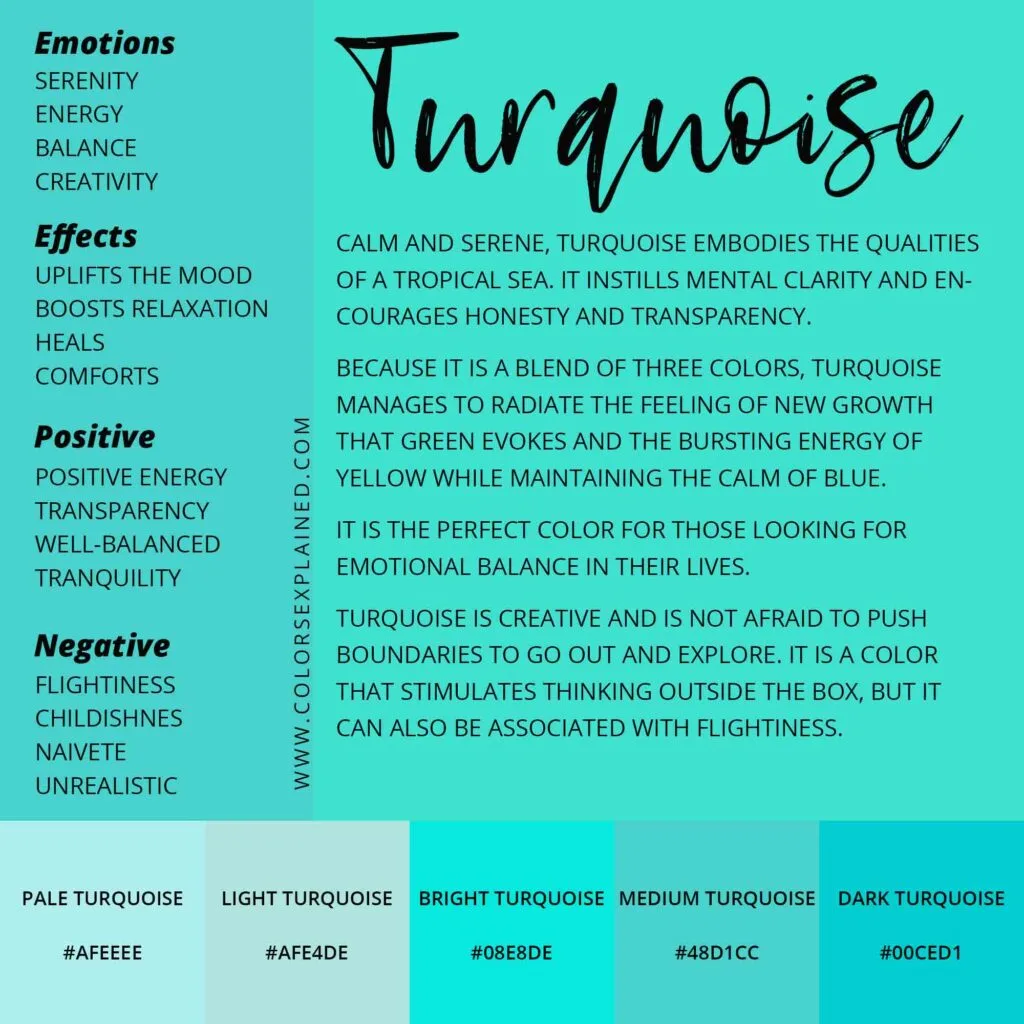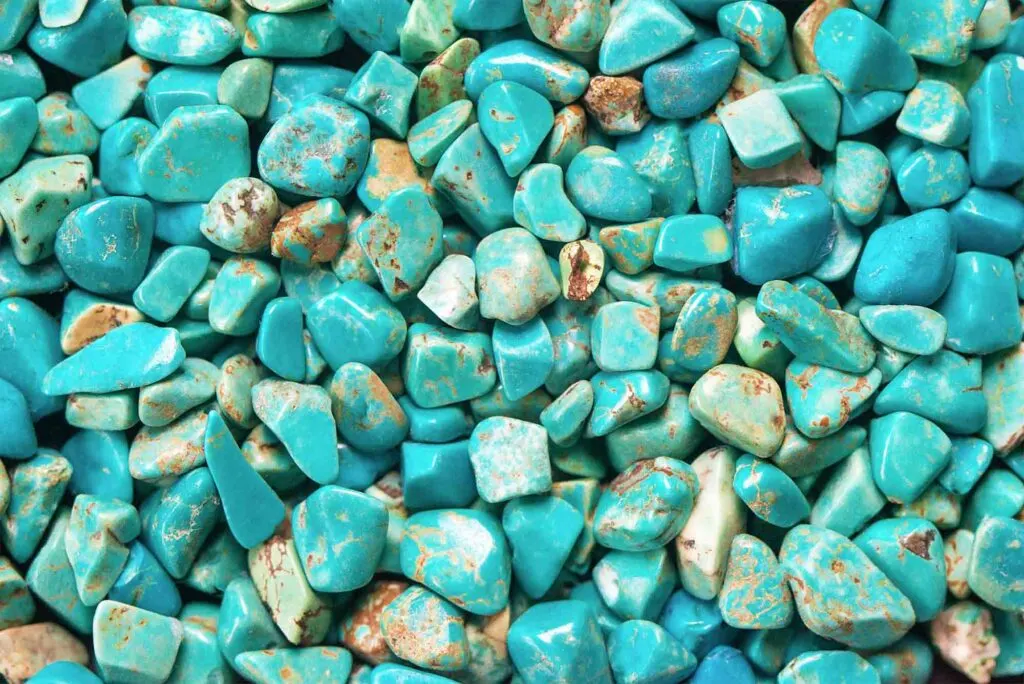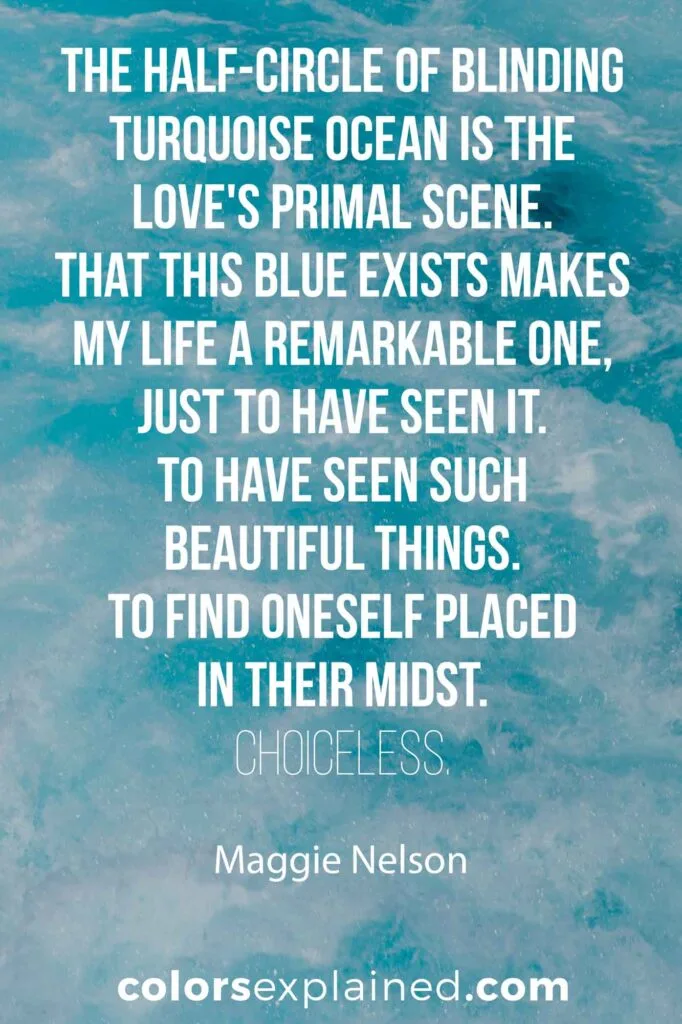Turquoise is the color of creativity, relaxation, and balance
Today’s article is about the symbolism and the meaning of the color turquoise as part of the Color Meaning Series.
For more colors, check out our guide on color meanings.

Where can we find the meaning of the color turquoise?
Is it on the tropical waters of the Caribbean sea or the energizing gemstone with the same name? Perhaps it is in the tail of a free-thinking mermaid.
Turquoise is a friendly and happy color that takes its name from the gemstone, which comes from the French word for Turkish.
In today’s article, we’ll talk about the symbolism and meaning of turquoise, its most common uses, company logos, and facts–all about turquoise.
Turquoise Color Symbolism in Different Cultures
- The name of the color turquoise is derived from the sea-green stone of the same name. The meaning of the color turquoise is inextricably linked with the stone’s symbolism.
- Ancient cultures believed in the turquoise stone’s ability to protect, promote tranquility, and encourage enduring love – all qualities that turquoise is still associated with today.
- Crystal experts today continue to celebrate the meaning of turquoise for its representation of wisdom, tranquility, and protection from harm and negative energy.
- The Native Americans, Lakota-Sioux and Navajo indigenous nations, believed turquoise attracted water and used it in rituals to call for rain. This association with water is still part of the color turquoise meaning for many people today.
- Ancient Greek young women wore turquoise as a symbol of purity.
- In Russia, turquoise symbolizes love.
- In England, young women used to give their lovers gifts of turquoise as symbols of enduring love.
- In many Asian countries, including China and Turkey, turquoise is thought to protect from the evil eye, which is why the stone has been used for centuries as protection amulets. In addition, the turquoise stone is seen as a powerful talisman of protection by Turkish soldiers.
What Does Turquoise Mean in the Bible?
The Bible used colors and numbers in figurative ways throughout its many books, and that’s also true for turquoise.
In the biblical meaning of the colors, turquoise symbolizes tranquility, patience, the New Jerusalem, and God’s healing (Psalm 65:9).
Psychological Meaning of Turquoise
Just like the color itself (a blend of yellow, green, and blue), turquoise’s meaning is multi-layered and complex.

Turquoise Color Meaning
Here’s some insight into turquoise’s meaning according to color psychology.
Calmness and Serenity
Imagine yourself standing on the deck of a ferry boat, looking down into clear turquoise waters below. It’s easy to imagine feeling perfectly tranquil in this situation, isn’t it? That’s what turquoise does to your mindset. It provides mental clarity.
And it doesn’t have to be water. It can be just about any glimpse of this color, whether it’s a piece of jewelry or a paint swatch.
Energy and Growth
Thanks to its specific blend of hues, turquoise manages to radiate the feeling of new growth that green evokes and the bursting energy of yellow while maintaining the calm of blue.

Open, Free Communication
Turquoise encourages honest, frank, clear communication, which is why it is associated with the throat chakra.
This applies to your communication with yourself (your inner monologue, how you relate to yourself, and how you articulate your wants and needs to yourself) and with others (talking with other people, communicating your emotions in conversation, and expressing your needs within relationships).
Joy and an Uplifted Mood
Can you imagine being in a bad mood when surrounded by clear tropical waters? Probably not.
Thanks to its yellow undertones, turquoise doesn’t carry the same melancholy association as the color blue often has.
Turquoise is a buoyant color, boosting your mood and giving you a burst of energy while keeping you calm and joyful, rather than frenetic and stressed.
Balance
Just as the color turquoise delicately balances its many undertones, having it around promotes emotional control and balance.
Free-spirited but not flighty, joyful but not over-stimulating, the fact that turquoise encompasses so many different hues in a single color manages to keep an even keel.

Creativity and Thinking Outside the Box
It’s no coincidence that one of the most iconic uses of the color turquoise – the mermaid protagonist Arielle’s tail in the classic Disney movie The Little Mermaid – depicts a free-thinking young woman itching for adventure outside the world she knows.
Turquoise encourages thinking beyond the world of reality, pushing boundaries, and exploring.
However, this can also have its downsides. Turquoise can be associated with flightiness, immaturity, and naivete, especially in its lighter tones.
It can be seen as an overly childish color, chasing after flights of fancy and going on imaginary adventures with pretended rewards instead of tackling life’s actual challenges and returning with triumphant (and honest) rewards and accomplishments.
One way to avoid this is to only use turquoise as an accent color. You can also opt for a darker, deeper shade of turquoise, which doesn’t carry the same flighty connotations.
Physical Effects of Turquoise
- When used as a meditation aid, turquoise boosts relaxation and mindfulness. Think about why some people prefer to meditate by the ocean or outdoors under the clear sky. The color turquoise can give some of those comforting, euphoric feelings of being near the water or outside.
- Some people believe that turquoise is a healing color. It’s often used to neutralize acidity, improve muscle strength, ease the symptoms of rheumatoid arthritis, aid in stomach infections, fight against viral infections, and enhance one’s hearing or sight. While these medical claims have yet to be substantiated, turquoise can certainly feel like a healing color to have around.
Some Shades of Turquoise
Here are a few popular turquoise shades with respective hex codes, which in truth are all shades of blue.
Pale Turquoise #AFEEEE
Light Turquoise #AFE4DE
Turquoise Green #A0D6B4
Turquoise Blue #00FFEF
Bright Turquoise #08E8DE
Turquoise #40E0D0
Medium Turquoise #48D1CC
Dark Turquoise #00CED1
Most Common Uses of the Color Turquoise
In branding, turquoise is often used by the following industries:
- Travel – very popular color for travel-related businesses
- Cleaning products
- Skincare
- Female jewelry
- Communications
- Design
Companies and Brands That Use Turquoise in Their Logo

Quotes About Turquoise
“The tones of gray, pale turquoise, and pink will prevail.” Christian Dior
“The half-circle of blinding turquoise ocean is the love’s primal scene. That this blue exists makes my life a remarkable one, just to have seen it. To have seen such beautiful things. To find oneself placed in their midst. Choiceless.” Maggie Nelson

Facts About Turquoise
- The word “turquoise” dates to the 17th century and is derived from the French turquois meaning “Turkish” because the mineral was first brought to Europe through Turkey, from mines in the historical Khorasan of Persia.
- The turquoise gemstone is the traditional birthstone of December and a gift for the 11th wedding anniversary.
Turquoise means: serenity, energy, and balance
Effects of turquoise: uplifts the mood, boost relaxation, and healing effects
Positive traits: positive energy, transparency, and well-balanced
Negative traits: flightiness, childishness, and naivete
